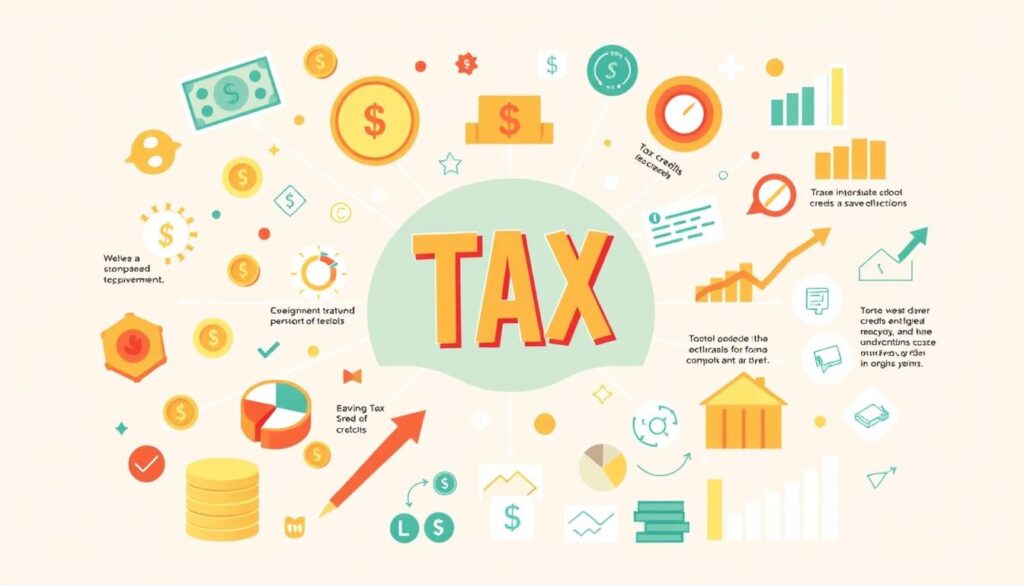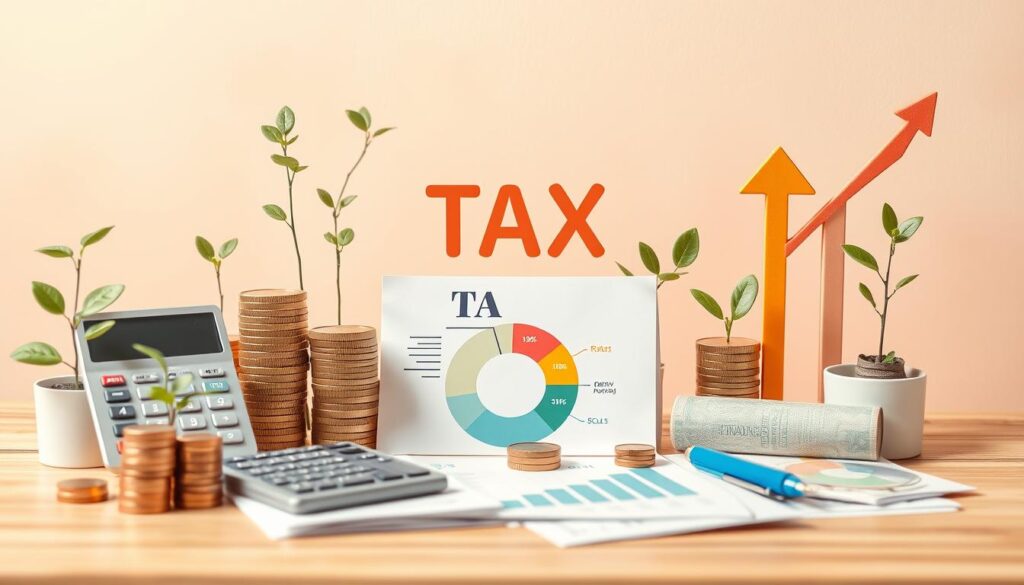Have you ever stared at a pile of paperwork, the weight of tax season pressing down on you, and wondered if there was a way to ease that burden? You’re not alone. The intricacies of tax benefits can feel overwhelming, yet the potential to maximize your savings is transforming for countless individuals like you. As the dust settles on each tax year, understanding how to navigate the maze of tax deductions, credits, and exemptions can not merely lighten your financial load but also open doors to opportunities you may never have considered. Imagine setting aside more for what truly matters – whether that’s investing in a home, saving for education, or boosting your retirement fund. With the right knowledge about tax benefits, you can reshape your financial landscape and secure the future you envision. Embrace the potential of tax savings and watch as the stress of tax breaks becomes a journey toward financial empowerment.
Key Takeaways
- Understanding tax benefits can significantly reduce your overall tax bill.
- Multiple types of tax benefits include deductions, credits, and exemptions.
- Maximizing savings requires knowledge of current tax laws and limits.
- Stay informed on changes to tax contributions and benefits each year.
- Utilizing tax breaks strategically can lead to substantial long-term gains.
Understanding Tax Benefits: What They Are
Tax benefits hold a significant role in reducing the burden of tax liabilities. Grasping the definition of tax benefits helps you understand various avenues available to lower your tax bills. These benefits encompass tax deductions, credits, and exemptions, all designed to lessen the amount of tax you owe.
Definition of Tax Benefits
The term tax benefits refers to provisions established by tax laws that enable taxpayers to minimize their taxable income or tax liability. Examples include the earned income tax credit, which allows eligible taxpayers to receive significant credits based on their income level and number of dependents1. Understanding tax benefits allows you to plan financially and maximize your savings throughout the tax year.
How Tax Benefits Work
Tax benefits function by providing ways to either reduce taxable income or directly lower your tax bills. For instance, the earned income tax credit can offer taxpayers a refund based on their qualifying income1. Tax deductions lower your total taxable income, like how a $2,000 deduction might shift your tax bracket from 22% to 12% in 20242. In contrast, tax credits directly reduce the amount of tax owed, providing a dollar-for-dollar reduction on the tax bill3.
Importance of Tax Benefits for You
Recognizing the importance of tax benefits can lead to substantial financial savings. Statistically, millions of taxpayers overlook available credits each year, resulting in forfeited tax savings of thousands of dollars1. Engaging with various tax credits and deductions can significantly enhance your financial standing over time. Notably, the standard deduction for 2024 benefits single filers with an amount of $14,600, which will increase to $15,000 in 20252. By staying informed about potential deductions and credits, taxpayers can substantially improve their financial planning.

Types of Tax Benefits You Can Claim
Understanding the different types of tax benefits can help you minimize your tax liability. Tax benefits primarily come in three forms: deductions, credits, and exemptions. Each type serves a distinct purpose in reducing your overall tax burden.
Deductions
Tax deductions are amounts that reduce your taxable income. They allow you to subtract specific expenses from your income, ultimately lowering your tax liability. For the 2024 tax season, the standard deductions are:
| Filing Status | Standard Deduction |
|---|---|
| Single filers and married couples filing separately | $14,600 |
| Joint filers | $29,200 |
| Heads of household | $21,900 |
Utilizing these deductions effectively can significantly impact your taxable income and, consequently, your taxes owed4.
Credits
Tax credits directly reduce the amount of tax you owe. They come in three forms: nonrefundable, refundable, and partially refundable. Nonrefundable credits can lower your tax liability to zero but not beyond, while refundable credits, such as the Earned Income Tax Credit, can lead to a tax refund5. Common tax credits include:
- Earned Income Tax Credit (EITC)
- Child and Dependent Care Credit
- Lifetime Learning Credit
- American Opportunity Tax Credit
The American Opportunity Tax Credit provides up to $2,500 for qualified education expenses, with the amount decreasing as income rises6.
Exemptions
Tax exemptions allow you to exclude certain amounts from your taxable income, which helps further reduce the tax burden. Common types of exemptions include those for health insurance, disability, and certain death benefits4. Understanding these can help you navigate your tax obligations more effectively.

How Tax Deductions Can Save You Money
Understanding the nuances of tax deductions can significantly enhance your savings. You have two main options: standard deductions and itemized deductions. Choosing the right path depends on your unique financial situation.
Standard vs. Itemized Deductions
The standard deduction for single filers in 2024 is set at $14,700, while married couples filing jointly may claim $29,4007. This provides a straightforward way to lower your taxable income without the need for extensive record-keeping. On the other hand, itemized deductions allow you to detail specific expenses that can also reduce your taxable income. This could include mortgage interest, state taxes paid, and qualifying charitable donations.
Common Itemized Deductions You Might Qualify For
If you choose to itemize, several common deductions could benefit you. These might include:
- Mortgage interest on loans used to buy, build, or improve your home
- State and local taxes (limited to $10,000)
- Charitable contributions up to 60% of adjusted gross income
- Medical expenses exceeding 7.5% of your adjusted gross income
- Student loan interest
For taxpayers with dependents, various credits can also affect financial strategy, such as the Earned Income Tax Credit, which supports individuals earning under a specified income level8.
The Impact of Deductions on Your Taxable Income
Both standard and itemized deductions have a direct impact on your taxable income. By lowering this figure, you may find yourself in a reduced tax bracket, allowing for substantial savings. For example, if you qualify for a mortgage interest deduction, the amount you claim reduces your taxable income, leading to possible tax refunds or lesser tax burdens overall.

Understanding these options empowers you to make informed decisions, maximizing your potential savings through tax deductions78.
The Power of Tax Credits
Tax credits represent one of the most impactful ways to reduce your tax liability. Unlike tax deductions, which decrease your taxable income, tax credits directly lower the amount you owe in taxes, offering a dollar-for-dollar reduction on your tax bill. Understanding the distinctions between these financial tools is crucial for maximizing your savings.
Difference Between Deductions and Credits
Tax deductions lessen your taxable income, while tax credits reduce the actual amount of tax owed. This means that when you utilize tax credits, you can achieve greater tax savings. Notably, tax credits can often play a bigger role in decreasing your overall tax burden compared to tax deductions, making them essential for effective tax planning9.
Common Tax Credits for Individuals
Many individuals can benefit from common tax credits, which include:
- The Child Tax Credit, providing up to $2,000 per qualifying child.
- The Earned Income Tax Credit (EITC), aimed at assisting lower-income families.
- Additional tax credits related to education and environmentally friendly home improvements, such as the solar energy credit, which offers significant savings on installation costs10.
How to Claim Your Tax Credits
Claiming tax credits requires thorough preparation. You must ensure you meet the specific eligibility criteria for each tax credit. The credits must be claimed on your tax returns, and it’s wise to consult tax professionals to help determine your qualifications. Different types of tax credits exist, including nonrefundable, refundable, and partially refundable credits, each with its own rules for claiming9.

| Type of Tax Credit | Description | Eligibility Criteria |
|---|---|---|
| Nonrefundable | Reduces tax liability to zero but does not provide a refund. | Lifetime Learning Credit, Saver’s Credit. |
| Refundable | Can result in a refund exceeding tax liability. | Earned Income Credit. |
| Partially Refundable | Reduces tax liability and adds a percentage to the refund. | American Opportunity Tax Credit. |
By taking advantage of the available tax credits, you can effectively increase your savings while maximizing the benefits you receive from the tax code9.
Understanding Tax Exemptions
Tax exemptions play a crucial role in determining your taxable income and can significantly affect your overall tax liability. While personal exemptions were suspended for tax years 2018 through 2025, understanding the remaining types of tax exemptions, such as dependent and special exemptions, is essential for maximizing your savings.
What Is a Tax Exemption?
A tax exemption reduces your income subject to tax, effectively lowering your overall tax bill. Each exemption benefits taxpayers by allowing them to deduct a specific amount from their taxable income. For instance, prior to 2018, the exemption amount for personal exemptions was $3,950, providing substantial savings for qualifying taxpayers11. Organizations that meet certain criteria, like charities, can also gain tax-exempt status, contributing to community services12.
Personal and Dependent Exemptions
Personal exemptions typically allowed taxpayers to claim a deduction for themselves and their spouses11. Although personal exemptions are currently unavailable, dependent exemptions are still relevant for those who care for qualifying children or other dependents. Taxpayers can claim one dependency exemption for each eligible dependent, making it essential to review your situation yearly to identify any qualifying individuals who can provide additional tax relief12.
Special Exemptions for Certain Groups
Special exemptions are designed for particular groups, including disabled veterans and certain nonprofit organizations. For example, in some states, specific exemptions allow telecommunication companies to avoid sales taxes, which helps encourage business growth12. Additionally, various property tax exemptions, such as homestead exemptions and those based on age or disability, provide further advantages to eligible individuals13.

Tax Benefits for Homeowners
Owning a home is not only a dream for many but also offers several appealing tax benefits for homeowners. Whether you’re a first-time buyer or a seasoned homeowner, understanding these benefits can significantly impact your finances.
Mortgage Interest Deduction
The mortgage interest deduction is one of the most significant tax benefits available. You can deduct interest paid on loans used to acquire, build, or improve your principal residence. In the upcoming 2024 tax year, the Tax Cuts and Jobs Act has capped the mortgage interest deduction limit at $750,000 for single filers or married couples filing jointly14. If married and filing separately, the limit is reduced to $375,000 for each party14. In fiscal year 2022, this deduction cost approximately $34.4 billion, indicating its significance to taxpayers15.
Property Tax Deductions
Property tax deductions allow you to deduct up to $10,000 as a married couple filing jointly or $5,000 if you are single or married filing separately. The property tax deduction saved homeowners around $5 billion in income tax in fiscal year 202215. This deduction is a useful way to ease your tax burden while benefiting from homeownership.
Energy-Efficient Home Improvements
Investing in energy-efficient improvements to your home can lead to additional tax incentives. Programs designed to promote sustainability often provide deductions or credits for homeowners who make qualifying upgrades. Not only do these improvements reduce your environmental impact, but they can also enhance the value of your home while providing tax benefits that contribute to your financial well-being.

In summary, the potential tax savings through mortgage interest deduction, property tax deductions, and energy-efficient improvements can add substantial value to your finances as a homeowner14.
Tax Benefits for Education Expenses
Education tax benefits can offer significant savings, helping you manage the rising costs of higher education. Understanding these benefits is crucial to maximizing your potential tax credits and deductions. Key options include the Lifetime Learning Credit, the American Opportunity Tax Credit, and student loan interest deductions.
Lifetime Learning Credit
The Lifetime Learning Credit allows you to reduce your tax liability by up to $2,000 for qualified education expenses. You can claim this credit for a variety of expenses, including tuition and fees for courses taken to acquire or improve job skills. There are no limits on the number of tax years you can claim this credit, which can be beneficial for those pursuing multiple years of education or vocational training. Note that the Lifetime Learning Credit is non-refundable, meaning it can reduce your tax bill to zero, but it won’t provide a refund if your credits exceed your tax liability1617.
American Opportunity Tax Credit
The American Opportunity Tax Credit can provide a credit of up to $2,500 per eligible student for qualified expenses incurred during the first four years of higher education. Eligible costs include tuition, mandatory fees, and books or supplies needed for courses1817. To qualify, your modified adjusted gross income must be below $80,000 (or $160,000 for joint filers), and the student must be enrolled at an eligible institution1617.
Student Loan Interest Deduction
If you’re paying interest on a qualified student loan, you might be able to deduct up to $2,500 from your taxable income, provided your modified adjusted gross income is under $80,000 for single filers or $160,000 for married joint filers1617. Qualified expenses include tuition, fees, room and board, and books16. Utilizing this deduction can effectively lower your overall tax liability, making it an essential aspect of educational tax benefits.

Health-Related Tax Benefits
Understanding health-related tax benefits is crucial for managing your healthcare costs efficiently. These benefits allow taxpayers to reduce taxable income through various deductions and credits associated with medical expenses. This section details the medical expense deductions, the advantages of Health Savings Accounts (HSAs), and the premium tax credit designed to make health insurance more affordable.
Medical Expense Deductions
Medical expense deductions can significantly ease the financial burden of healthcare. Taxpayers can deduct their qualified unreimbursed medical care expenses that exceed 7.5% of their adjusted gross income (AGI) for the year1920. Deductible medical expenses include payments to various medical practitioners such as doctors and dentists, as well as costs for treatments like acupuncture or services related to substance abuse and smoking cessation19. Expenses may also cover necessary medical equipment, prescription drugs, hospital care, and transportation costs essential for medical appointments1920. Keep in mind, not all expenses qualify, such as insurance premiums paid by employers or cosmetic procedures20.
Health Savings Accounts (HSAs)
Health Savings Accounts provide a tax-efficient way to save for medical expenses. Contributions to HSAs are tax-deductible, meaning they reduce your taxable income when you contribute21. These accounts can be used for qualified medical expenses, offering you valuable tax advantages while ensuring that you have the funds necessary for healthcare needs. Additionally, self-employed individuals can deduct 100% of their health insurance premiums under HSAs, adjusting their taxable income effectively21.
Premium Tax Credit for Health Insurance
The premium tax credit assists in making health insurance more accessible and affordable. Approximately nine out of ten enrollees benefit from financial assistance that lowers their health insurance costs, with many paying $10 or less per month21. This credit is particularly beneficial for low to moderate-income families and individuals who purchased their coverage through government marketplaces such as Covered California. Small businesses are also eligible for federal tax credits when they secure health insurance for their employees. Understanding these provisions allows you to maximize your savings while ensuring proper health coverage21.

Retirement Contributions and Tax Benefits
Planning for retirement is crucial for securing your financial future. Understanding the various options available for retirement contributions, such as Traditional IRAs, Roth IRAs, and 401(k) plans, can help you make informed decisions. Utilizing tax benefits available for these accounts can enhance your savings and reduce your taxable income.
Traditional vs. Roth IRAs
When considering retirement contributions, Traditional IRAs and Roth IRAs each provide unique tax benefits. Traditional IRAs allow tax-deferred growth, meaning you won’t pay taxes on your contributions or earnings until you withdraw them in retirement. Roth IRAs, on the other hand, allow for tax-free withdrawals after you reach age 59 ½, giving you more flexibility in managing your tax situation during retirement. The choice between these accounts may depend on your current tax bracket and what you anticipate your tax bracket will be upon retirement.
401(k) Contributions and Employer Matches
Many employers offer 401(k) plans that come with significant tax benefits. For 2024, you can contribute up to $23,000 annually to your 401(k) plan, with an additional catch-up contribution of $7,500 if you are 50 or older22. Taking full advantage of any employer matching contributions can significantly increase your retirement savings. These employer matches often function as “free money,” amplifying your 401(k) benefits while reducing your current taxable income.
Tax Benefits of Early Retirement Accounts
Utilizing early retirement accounts can greatly enhance your savings strategy. The Saver’s Credit, a tax credit for retirement contributions, offers a percentage credit ranging from 50% to 10% based on your adjusted gross income (AGI)23. This means that if you contribute to your retirement accounts, you could see a reduction in your tax bill, with maximum contributions that qualify being $2,000 for individuals or $4,000 for couples filing jointly23. Understanding these tax benefits is essential for maximizing your retirement contributions and ultimately enjoying a secure retirement.

By carefully weighing your options among Traditional IRAs, Roth IRAs, and 401(k) accounts, you can create a robust retirement savings plan that leverages the benefits available to you23.
Tax Benefits for Charitable Contributions
Charitable contributions offer individuals and businesses an effective way to give back to the community while benefiting from tax relief. Understanding how to maximize charitable donation deductions can provide significant savings on your taxes. Various types of charitable contributions exist, each with its own deductibility limits and requirements, making it essential to know how they work.
How to Deduct Charitable Donations
To deduct charitable donations, you must ensure that the contributions are made to qualified organizations. Taxpayers can generally deduct contributions up to 50 percent of their adjusted gross income (AGI). For certain individuals and organizations, this limit could rise to 100 percent depending on the type of contribution and recipient organization24. Donating long-term appreciated assets, such as stocks or real estate, allows for a deduction based on their full fair market value, which can provide even higher tax benefits25.
Types of Charitable Contributions
Different types of charitable contributions include cash donations, gifts of property, and contributions of appreciated assets. Cash donations are the most straightforward to deduct, while gifts of property may require additional documentation. It’s important to note that the contributions to certain entities, such as private foundations, come with stricter limits on deductions, often capped at 30 percent of your AGI24. Understanding these types can help streamline your tax strategy.
Limits on Charitable Deductions
Limits on deductions depend significantly on the nature of the contribution and the recipient organization. For instance, contributions to public charities may allow deductions of up to 50 percent of AGI, while donations to private foundations and similar organizations often have a lower cap. These limits are set to prevent abuse of the deduction process24. Families and individuals collectively give more than $1 billion to charity daily, reflecting the importance of understanding these opportunities for effective tax planning25.

Tax Strategies to Maximize Your Benefits
By utilizing effective tax strategies, you can significantly enhance your ability to maximize tax benefits. Implementing techniques like timing deductions can make a considerable difference in your overall tax position. As tax laws and personal circumstances evolve, regular evaluation is key to ensuring you are on the right track.
Timing Your Deductions
Timing deductions becomes essential, especially when it comes to year-end financial planning. By strategically deferring or accelerating certain expenses, you can potentially lower your taxable income. For instance, planning your deductible medical expenses can help ensure they exceed the 7.5% threshold of your adjusted gross income (AGI) for maximum effectiveness26.
Bunching Deductions for Tax Years
Bunching deductions can be an advantageous strategy to reduce tax liability over multiple years. By grouping expenses such as charitable contributions or medical expenses into a single year, you may exceed the standard deduction limit, allowing for greater itemized deductions. Many taxpayers, about 75%, opt for the standard deduction rather than itemizing, but strategic bunching can help those who itemize benefit more27.
Reviewing Your Tax Situation Annually
A comprehensive tax situation review on an annual basis is vital. This allows for necessary adjustments based on changes in income, expenses, or tax laws. It is recommended to re-evaluate your contributions to retirement accounts, as maximizing contributions can lead to advantageous tax outcomes. For instance, in 2024, you can contribute up to $23,000 to a 401(k), or even $30,500 if over 50, shielding that income from taxes for the present period28.

| Strategy | Details | Potential Tax Benefit |
|---|---|---|
| Timing Deductions | Deferring or accelerating expenses to influence taxable income | Lower tax liability |
| Bunching Deductions | Grouping deductions to exceed the standard deduction | Higher itemized deductions |
| Annual Tax Review | Re-evaluating your financial situation each year | Maximized tax efficiency |
Implementing these tax strategies can lead to significant financial benefits while ensuring compliance with the latest tax regulations. Take control of your tax planning for a brighter financial future262827.
Common Mistakes to Avoid with Tax Benefits
When navigating tax benefits, taxpayers can fall into traps that lead to common tax mistakes and tax benefit errors. Understanding these pitfalls can help you maximize your savings and avoid unnecessary penalties. Here are the key areas to watch for:
Not Keeping Proper Records
Keeping tax records is essential for smooth tax processing. Incomplete or missing documents can complicate your claims for deductions and credits. Tax software can assist in preventing math errors, yet it remains crucial to thoroughly review your tax return for accuracy29. Many taxpayers suffer from processing delays due to incorrect or missing Social Security numbers (SSNs)29.
Overlooking Available Deductions and Credits
Commonly overlooked deductions can limit your savings significantly. Mistakes in calculating credits like the Earned Income Tax Credit or the Child Tax Credit may lead to missed opportunities for savings. Incorrect filing status is a frequent error as well; taxpayers often choose the wrong status when filing29. Checking with resources like the Interactive Tax Assistant on IRS.gov can guide you in selecting the correct filing status29.
Filing Errors That Could Cost You
Filing errors can have costly implications. Math errors tend to occur, ranging from simple addition mistakes to more complex calculations29. Embracing electronic filing and direct deposit is encouraged by the IRS, as it usually accelerates the refund process29. For those eligible, IRS Free File offers free tax return preparation and electronic filing to help minimize errors29.

| Error Type | Description | Potential Impact |
|---|---|---|
| Missing SSN | Failure to include or incorrectly entering Social Security numbers. | Processing delays can result in late penalties. |
Resources for Navigating Tax Benefits
Utilizing the right resources simplifies your journey through the often-complex tax landscape. The IRS offers a range of tools and publications designed to help taxpayers understand their obligations and entitlements clearly. By leveraging these tax resources, you can make the most of available benefits and ensure compliance with tax laws.
IRS Resources and Tools
The IRS provides numerous tools, including the Volunteer Income Tax Assistance (VITA) program, which returned $1.8 billion to low- and moderate-income households last year30. Military families benefit from specialized tax assistance that addresses unique circumstances. Furthermore, taxpayers can access free tax preparation services through the VITA, TCE, and AARP Tax-Aide programs, available for qualifying individuals30.
Tax Preparation Software Recommendations
Selecting the right tax preparation software can streamline your filing process, ensuring you accurately claim eligible deductions and credits. Popular options like TurboTax, H&R Block, and TaxSlayer offer user-friendly platforms that guide you through tax preparation steps. Each software is equipped with features like automatic calculations, which help avoid common errors and maximize your refunds. The IRS office in Detroit, for instance, operates Monday through Friday, providing additional assistance by appointment for those needing help navigating the software30.
Seeking Professional Help
Sometimes, the best choice is to seek tax professional help. Engaging a tax expert not only personalizes advice but also minimizes the risk of mistakes that can lead to penalties. With the ongoing changes in tax laws, staying informed through professional guidance enhances your financial strategies. Additionally, individuals contributed an impressive $319 billion to charity in 2022, which reflects the important tax benefits available through charitable contributions and their potential for tax deductions31.

Staying Updated on Tax Law Changes
Tax laws evolve constantly, making it vital for you to stay informed about any updates or changes. Understanding the nuances of these tax law changes will not only help you in maximizing your tax benefits but also ensure you are not caught off guard by new regulations. A well-informed taxpayer can adapt their strategies more effectively, reducing the risk of errors and enhancing overall financial outcomes.
Importance of Staying Informed
Keeping current on tax law changes can significantly reduce mistakes when preparing your tax returns. As tax laws can vary significantly from year to year and even include last-minute adjustments, being aware of these shifts is crucial for accurate filing and compliance32. Furthermore, clients often have greater confidence in tax professionals who actively stay updated, which can lead to increased satisfaction and potential recommendations32.
Following Relevant News and Updates
To maintain your knowledge of tax news, consider utilizing resources such as the IRS website or subscribing to financial newsletters. Engaging with peers in the tax profession and taking refresher courses can also enhance your grasp of new laws. Statistics reveal that 66% of tax professionals believe their clients value comprehensive advice, underscoring the importance of being well-versed in recent legal changes33.
How Changes Might Affect Your Tax Situation
Finally, being proactive about understanding the impact of these tax law changes on your personal or business finances is essential. Familiarize yourself with upcoming changes to deductions, credits, and other tax benefits to strategize effectively. Staying informed empowers you to make timely decisions that can significantly affect your tax outcomes, ultimately paving the way for financial success34.
FAQ
What are tax benefits?
How do tax deductions work?
What is the difference between tax credits and tax deductions?
Are there specific tax credits available for families?
Can I claim tax benefits if I own a home?
What education-related tax benefits can I claim?
How do health-related tax deductions work?
What tax benefits do retirement accounts offer?
How can charitable contributions benefit my taxes?
What strategies can help maximize my tax benefits?
What are common mistakes taxpayers make with tax benefits?
Where can I find resources to help understand tax benefits?
Why is it important to stay updated on tax laws?
Source Links
- https://www.irs.gov/newsroom/tax-credits-for-individuals-what-they-are-and-how-they-can-benefit-taxpayers – Tax credits for individuals: What they are and how they can benefit taxpayers
- https://www.investopedia.com/terms/t/tax-benefit.asp – Tax Benefit: Definition, Types, and IRS Rules
- https://turbotax.intuit.com/tax-tips/general/what-are-tax-benefits/L39rp7Pva – What Are Tax Benefits?
- https://www.peoplekeep.com/blog/tax-exclusions-vs-tax-deductions-vs-tax-credits-in-healthcare – Tax Exclusion vs. Tax Deduction vs. Tax Credit
- https://www.investopedia.com/terms/t/taxcredit.asp – Tax Credit: What It Is, How It Works, What Qualifies, 3 Types
- https://turbotax.intuit.com/tax-tips/tax-deductions-and-credits/the-5-biggest-tax-credits-you-might-qualify-for/L3o8qrNnC – The 5 Biggest Tax Credits You Might Qualify For
- https://www.irs.gov/credits-and-deductions-for-individuals – Credits and deductions for individuals
- https://www.nerdwallet.com/article/taxes/tax-deductions-tax-breaks – 22 Popular Tax Deductions and Tax Breaks – NerdWallet
- https://www.empower.com/the-currency/life/tax-credits – Tax credits: Everything you need to know
- https://www.energy.gov/eere/solar/homeowners-guide-federal-tax-credit-solar-photovoltaics – Homeowner’s Guide to the Federal Tax Credit for Solar Photovoltaics
- https://apps.irs.gov/app/understandingTaxes/teacher/hows_mod06.jsp – Understanding Taxes – Module 6: Exemptions
- https://turbotax.intuit.com/tax-tips/irs-tax-return/what-are-tax-exemptions/L5xCsvZKO – What Are Tax Exemptions?
- https://www.investopedia.com/articles/personal-finance/031615/how-do-tax-exemptions-work-your-favor.asp – How Do Tax Exemptions Work?
- https://www.rocketmortgage.com/learn/tax-deductions-for-homeowners – 7 Tax Deductions For Homeowners: Your Breaks And Benefits
- https://taxpolicycenter.org/briefing-book/what-are-tax-benefits-homeownership – What are the tax benefits of homeownership?
- https://www.irs.gov/newsroom/tax-benefits-for-education-information-center – Tax benefits for education: Information center
- https://www.nerdwallet.com/article/loans/student-loans/education-tax-credits – American Opportunity Tax Credit and Other Education Tax Credits for 2023 – NerdWallet
- https://www.irs.gov/credits-deductions/individuals/education-credits-aotc-llc – Education Credits AOTC LLC | Internal Revenue Service
- https://www.irs.gov/taxtopics/tc502 – Topic no. 502, Medical and dental expenses
- https://turbotax.intuit.com/tax-tips/health-care/can-i-claim-medical-expenses-on-my-taxes/L1htkVqq9 – Are Medical Expenses Tax Deductible?
- https://www.coveredca.com/marketing-blog/health-insurance-tax-credits-deductions-and-more/ – Health Insurance Tax Credits, Deductions & More
- https://turbotax.intuit.com/tax-tips/retirement/tax-benefits-of-retirement-accounts-comparing-401ks-403bs-and-iras/L6ChGOXHE – Tax Benefits of Retirement Accounts: Comparing 401(k)s, 403(b)s, and IRAs
- https://www.irs.gov/retirement-plans/plan-participant-employee/retirement-savings-contributions-credit-savers-credit – Retirement Savings Contributions Credit (Saver’s Credit)
- https://www.irs.gov/charities-non-profits/charitable-organizations/charitable-contribution-deductions – Charitable contribution deductions | Internal Revenue Service
- https://www.fidelitycharitable.org/guidance/charitable-tax-strategies/charitable-contributions.html – Charitable contributions: tax strategies
- https://www.investopedia.com/how-to-maximize-your-tax-return-8422348 – How to Maximize Your Tax Return
- https://turbotax.intuit.com/tax-tips/tax-planning-and-checklists/top-8-year-end-tax-tips/L5szeuFnE – Top 8 Year-End Tax Tips
- https://www.investopedia.com/articles/personal-finance/032116/top-6-strategies-protect-your-income-taxes.asp – 6 Strategies to Lower Your Tax Bill
- https://www.irs.gov/newsroom/common-tax-return-mistakes-that-can-cost-taxpayers – Common tax return mistakes that can cost taxpayers
- https://thanedar.house.gov/tax-resources – Tax Resources | U.S. Congressman Shri Thanedar
- https://www.cancerresearch.org/blog/march-2024/navigating-charitable-donations-and-tax-benefits – Navigating Charitable Donations and Tax Benefits | CRI
- https://certifiedtaxcoach.org/new-tax-law/ – Staying Current with New Tax Laws – Certified Tax Coach
- https://tax.thomsonreuters.com/blog/how-to-keep-up-with-tax-law-changes/ – How to keep up with tax law changes
- https://www.irs.gov/newsroom/irs-releases-tax-inflation-adjustments-for-tax-year-2025 – IRS releases tax inflation adjustments for tax year 2025









